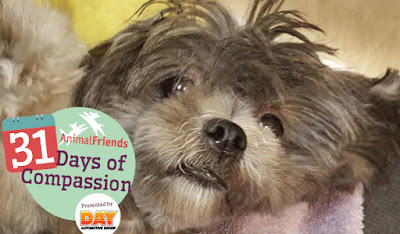A few months ago we met a man named Gary who lived in Pittsburgh’s North Side with his Shih Tzu, Sam. We introduced him to our Animal Friends for Life program, which focuses on specific communities in need of free services. Since Sam was behind on his vaccinations and hadn’t been neutered, we encouraged Gary to take advantage of the program. He was not interested in the idea of having Sam neutered, fearing that it would change his behavior and personality. So each time we saw him, we were able to teach him more about the many benefits of having his beloved pet neutered and hope that he would reconsider.
After some time, Gary agreed to have Sam neutered and vaccinated. In the following days, we picked up Sam and brought him to Animal Friends for his exam and surgery. We quickly realized that we were lucky to meet Gary when we did. Sam was cryptorchid, meaning that one testicle had not descended, putting him at a much higher risk of cancer.
Once he had recovered from surgery, we brought Sam back to his home. As we walked toward Gary’s front door, we met Nancy, one of his neighbors. She had seen us with Gary’s dog and was curious about who we were and what we were doing. It wasn’t long before we learned that Nancy wasn’t just a neighbor – she was a Shih Tzu breeder and had sold Sam to Gary.
As it turns out, Nancy had four dogs of her own. With no access to an affordable clinic, they had never seen a veterinarian. We told Nancy about the importance of spaying and neutering and explained that breeding could have a negative effect on the health and well-being of her dogs. Although she loved them dearly, these dogs were not just pets to her – they were her livelihood.
About a month and several conversations later, Nancy finally agreed to have her dogs spayed and neutered. After our compassionate staff performed the spays, neuters, exams and blood tests we learned that these sweet pups were in need of much more than routine surgery. One of them was suffering from severe periodontal disease, a bacterial infection of the mouth. During surgery, another was found to have numerous cysts on her uterus and ovaries. Nancy’s decision to allow us to spay and neuter her dogs could have quite literally saved their lives.
We started Animal Friends for Life not just as a way to provide affordable and accessible wellness services, but to inform underserved communities about how to keep their companion animals healthy. By giving Gary information and resources, we were able to make certain that Sam was healthy. And, by helping Gary, we met Nancy and helped her pets continue to live long, healthy and happy lives, too!
At Animal Friends, every day is full of compassion. Visit ThinkingOutsideTheCage.org/31Days to turn your compassion into action. After all, it only takes one day to alter a life.


Comments
Post a Comment